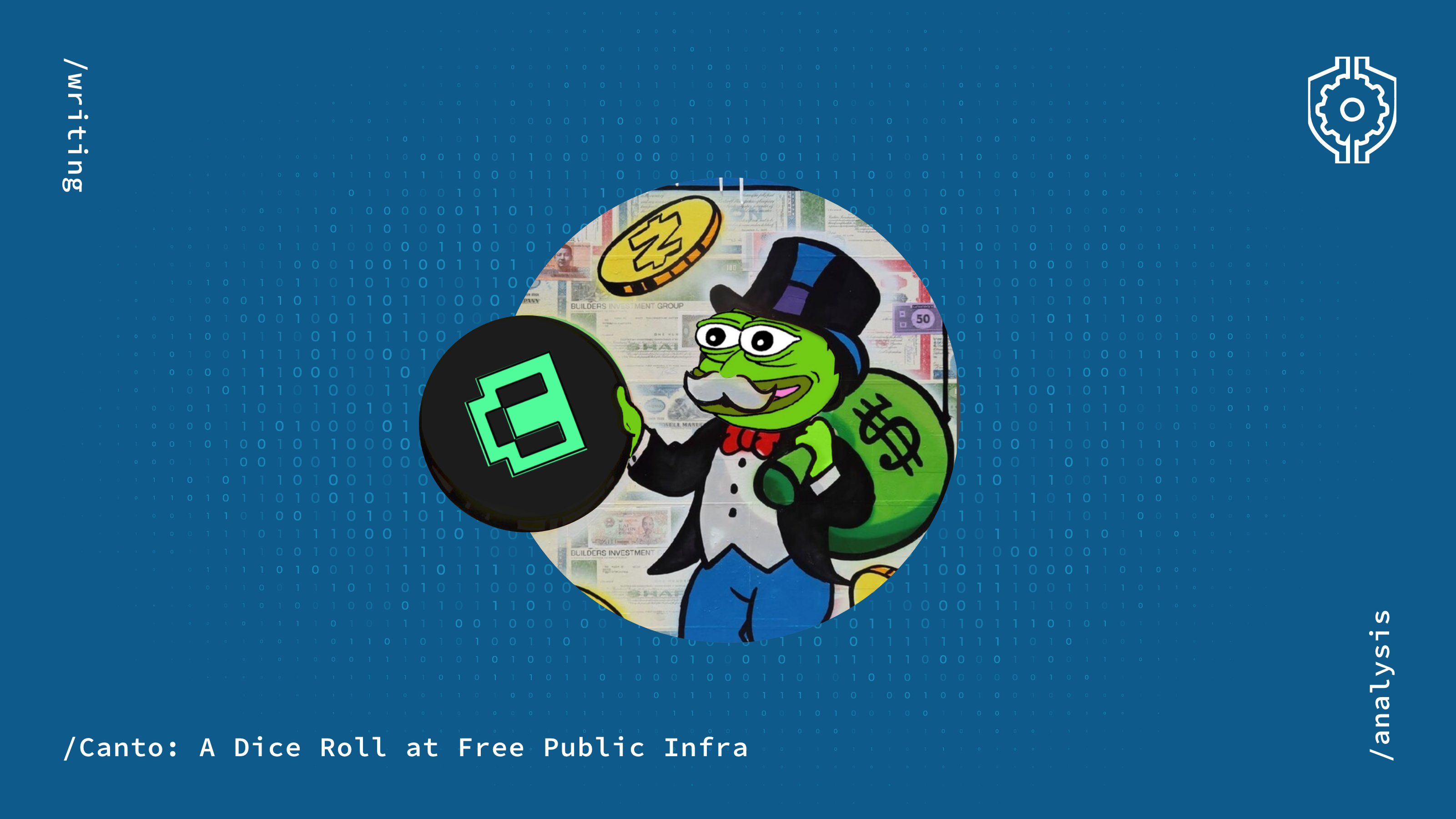Canto: A Dice Roll at Free Public Infra
The Canto launch garnered hype across the board. Has it made $NOTE-worthy progress on its mission? Let's assess its current state, risks, and potential outcomes.

Rich Uncle Pennybags (aka, Mr. Monopoly) would love crypto. It blends casual gambling, canines, and even jail time.
It is interesting to think about how the magnate would view Free Public Infrastructure as a business proposition. Whether he would scoff at the altruistic vision or see an opportunity.
In this article we take a puff-free look at Canto, and what it can and can’t do, and share some predictions on its state when the bull market rolls in again.
Structure
Free Public Infrastructure is a powerful proposition in an industry where chasing gains can often dominate. It pitches it as a wholesome good against a wave of money-grabs. It is juicy PR, on par with tokenizing carbon credits.

The ecosystem itself is built on a triforce of public-good amenities: a DEX, a lending market, and unit of account ($NOTE). The Canto DEX is free to use and will never be subject to governance or fees. The lending market, which is free for LPs, is directed by network stakers. $NOTE is its overcollateralized stablecoin, with a self-adjusting interest rate to buffer volatility.
Tokenomics
A second token - $CANTO - acts as the network and governance token. The max supply of $CANTO is designed to increase over time, but at a decaying rate of distribution.
Theoretically, inspiring builders to build and apes to ape in an ecosystem built on free use should be a difficult task. Where does the participation value come from?
Well, $CANTO is used liberally across the network to provide the following rewards:
Liquidity mining incentives
Staking incentives
Network security incentives
In addition, the ecosystem’s Contract Secured Revenue (CSR) mechanism provides an add-on to smart contracts that developers can use to generate a fixed 20% revenue from fees that the network would usually burn. To do this, developers create a CSR NFT that accrues value and acts as a treasury for each dApp.
Operations
A core angle in the Canto vision is that it is completely decentralized and free from dominating, singular influences, such as VCs.
There is no core team. Instead, the early contributors that developed the ecosystem have stepped back from any majority claim of ownership. The two most prominent names from that stable of early contributors are Scott Lewis, DeFi Pulse co-founder, and Plex, a Web3-native group of developers. One quirk of this genesis structure is that these builders’ $CANTO allocations are not vested.
An effect of having no core team is that there is also no pre-set roadmap. The decision-making process has relied on governance to craft the early vision and development path. This governance responsibility includes making changes to protocol fees, adjusting emissions, and registering new tokens in the Canto EVM.
Predictions
The core vision of Canto, and as outlined in its tenets, is certainly a worthy mission. Crypto can be far too concerned with TVL (ironically, as Scott Lewis claims to have invented it), when instead the betterment of communities should dictate our thinking.
While we have discussed Web3 coordination at length in various articles, Canto has put itself at the foot of a giant mountain. Coordination with an outlined vision can be tasking enough, but it is uniquely challenging when one is lacking.
Excluding any black swan events (like COVID and mass money printing), the future looks blurred here, and these are likely some of the trials that Canto will face.
Wash Activity
Constructing CSR as an optional add-on to a deployment has the potential to shift the network monopoly from validators to dApp deployers.
It is a two-fold issue. Firstly, wash network activity or stealth marketing could be used to manipulate and boost specific developer revenues. Secondly, by making the revenue fee variable, it is likely only a matter of time before developers on the network will look to vote and increase that figure.
Both of these outcomes could ultimately undercut the public-good premise of Canto by introducing politics and vote gaming, which would kick-start a trend of rent-seeking behavior that the network has been created to protect against.
(De)composability
The ecosystem’s current economic structure could stifle growth where it matters most: cross-chain. We are at a precipice in blockchain development where composability, and working together to leverage strengths, will be a key driver in scalable progress. There won’t be one winner of the Chain Wars after all.
While building on the Cosmos SDK certainly facilitates this kind of development, there currently isn’t any indication within the vision to pursue cross-chain ambitions that can keep pace with the rest of the market.
Developers will want to build where it will create the greatest impact; and in its current, shuffling state, Canto is at risk of fencing itself off into irrelevancy.
Pseudo-governance
As covered above, governance can be a juggle between coordination and incentivization. In its current state, Canto does not provide enough reward for users who are interested in anything other than flipping the $CANTO token as short-term play.

With no vesting for early contributors, and large funds now taking sizeable positions, it is difficult to distinguish how the Canto ecosystem setup is any different from the protocols that are often touted as being manipulated by big players, such as Uniswap.
The outcome is likely that those early contributors, with influence from other majority stakeholders, will govern and direct the vision of Canto in a way that doesn’t reflect a unified ecosystem voice.
Useful links:
Dune | Canto Value Bridged from Ethereum (@smyyguy)
Artemis | Network Activity Overview
Canto Docs
